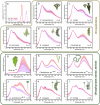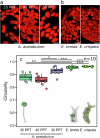Loss of state transitions in Bryopsidales macroalgae and kleptoplastic sea slugs (Gastropoda, Sacoglossa)
- PMID: 40473784
- PMCID: PMC12141491
- DOI: 10.1038/s42003-025-08305-3
Loss of state transitions in Bryopsidales macroalgae and kleptoplastic sea slugs (Gastropoda, Sacoglossa)
Abstract
Green macroalgae within the order Bryopsidales lack the fundamental photoprotective mechanisms of green algae, the xanthophyll cycle and energy-dependent dissipation of excess light. Here, by measuring chlorophyll fluorescence at 77 K after specific light treatments, we show that Bryopsidales algae also lack state transitions, another ubiquitous photoprotection mechanism present in other green algae. Certain Sacoglossa sea slugs can feed on Ulvophyceae algae, including some Bryopsidales, and steal chloroplasts - kleptoplasts - that remain functional inside the animal cells for months without the support of the algal nucleus. Our data reveal that the state transition capacity is not retained in the kleptoplasts of the sea slugs, and we provide evidence that the loss is caused by structural changes during their incorporation by the animals. Enforced chloroplast sphericity was observed in all studied kleptoplastic associations, and we propose that it is a fundamental property supporting long-term retention of kleptoplasts in photosynthetic sea slugs.
© 2025. The Author(s).
Conflict of interest statement
Competing interests: The authors declare no competing interests. Ethics approval: This study was performed in accordance with EU legislation and directives concerning scientific research on animals, including the 3 R principles. Ethical approval is not required for studies conducted with non-cephalopod invertebrates. Wild algae and sea slugs were collected from non-protected marine coastal areas. Laboratory-reared specimens used in this work were maintained in optimized life-support systems to ensure animal welfare.
Figures








Similar articles
-
Food shaped photosynthesis: Photophysiology of the sea slug Elysia viridis fed with two alternative chloroplast donors.Open Res Eur. 2024 Mar 13;3:107. doi: 10.12688/openreseurope.16162.2. eCollection 2023. Open Res Eur. 2024. PMID: 38725452 Free PMC article.
-
Photosynthetic sea slugs induce protective changes to the light reactions of the chloroplasts they steal from algae.Elife. 2020 Oct 20;9:e57389. doi: 10.7554/eLife.57389. Elife. 2020. PMID: 33077025 Free PMC article.
-
Photoprotection in sequestered plastids of sea slugs and respective algal sources.Sci Rep. 2015 Jan 20;5:7904. doi: 10.1038/srep07904. Sci Rep. 2015. PMID: 25601025 Free PMC article.
-
Photophysiology of kleptoplasts: photosynthetic use of light by chloroplasts living in animal cells.Philos Trans R Soc Lond B Biol Sci. 2014 Mar 3;369(1640):20130242. doi: 10.1098/rstb.2013.0242. Print 2014 Apr 19. Philos Trans R Soc Lond B Biol Sci. 2014. PMID: 24591722 Free PMC article. Review.
-
Crawling leaves: photosynthesis in sacoglossan sea slugs.J Exp Bot. 2013 Oct;64(13):3999-4009. doi: 10.1093/jxb/ert197. Epub 2013 Jul 11. J Exp Bot. 2013. PMID: 23846876 Review.
Cited by
-
Low-Cost Microalgae Cell Concentration Estimation in Hydrochemistry Applications Using Computer Vision.Sensors (Basel). 2025 Jul 27;25(15):4651. doi: 10.3390/s25154651. Sensors (Basel). 2025. PMID: 40807815 Free PMC article.
References
-
- de Negri, A. & de Negri, G. Farbstoff aus Elysia viridis. Ber. Dtsch. Chem. Ges.9, 84 (1876).
-
- Christa, G. Kleptoplasty. Curr. Biol.33, R465–R467 (2023). - PubMed
MeSH terms
LinkOut - more resources
Full Text Sources

